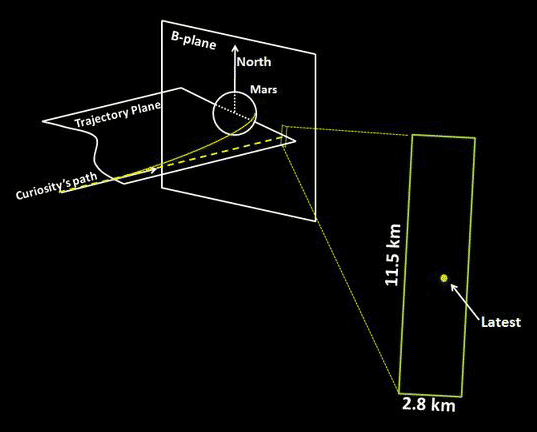Emily Lakdawalla • Aug 04, 2012
Curiosity landing minus two days
I just came out of a press briefing at JPL, on the morning of the day before the landing. The panel seemed fairly calm -- anxious, certainly, but the happy kind of anxiety that precedes something that could be great. I won't try to summarize everything that was said -- I'll leave that to the news journalists who were in the room, people like Alan Boyle, Kenneth Chang, and Irene Klotz -- but will hit some of the high points of information that was new to me.
The most informative discussion came after the briefing when I asked Richard Cook a couple of questions about communications. I wondered why they had chosen to land at such a time that the Earth would set over the horizon from Curiosity's view while the spacecraft was under parachute. Wouldn't they want to have direct-to-Earth communication the whole way down? He said that the choice was a difficult trade among many variables mostly having to do with the timing of orbiter overflights, and ultimately they had to choose between one more orbiter and the continuity of direct-to-Earth communication. The orbiters can receive so much more information from Curiosity's transmissions that they chose to prioritize orbiter communication, and allow the interruption of direct-to-Earth transmission.
He explained to me that Odyssey and Mars Reconnaissance Orbiter are actually listening to Curiosity in quite different ways. (I apologize in advance for any inaccuracies in my summary of Cook's explanation -- it's a bit out of my depth.) Odyssey, which will be performing a bent-pipe relay (which means it'll send data onward to Earth in real time as it receives it from Curiosity), will be in telemetry lock with Curiosity, such that it will be listening at a specific frequency, decoding Curiosity's signals as it receives them, and sending the decoded signal back to Earth.
Mars Reconnaissance Orbiter, on the other hand, will be listening to Curiosity's UHF signal in the same way that the DSN dishes will be listening to Curiosity's direct-to-Earth transmissions. They'll be doing what's called open-loop recording, listening across a relatively broad frequency band, recording everything in that band without attempting to decode the signal. This generates a huge amount of data, much more than Odyssey's live stream will. Once Mars Reconnaissance Orbiter has transmitted that huge pile of data to Earth, the signal must be processed. This method of recording will prove invaluable in the case of a problem with the landing, because by listening in a way that's not dependent on everything working right, they'll have a chance to record information that other receivers might miss. The cost is that it takes longer to receive and to process that huge amount of data.
OK, on to some other, smaller details, best put in bullet points:
- A little summary of current spacecraft health: Data is being received from it at 2000 bps at Madrid at the moment. The batteries are charged to 100%. Targeting is very good: they're aiming for a box at the top of the atmosphere that is 2.8 by 11.5 kilometers and their current predict has them extremely close to the center of that box. So close that they canceled their opportunity to adjust the trajectory (TCM 5) last night.
- Their last command before landing will happen this evening, when they enable the contingency software on the backup computer. This software is designed to take over and land the spacecraft if the main computer should reset during landing (a very unlikely event). The contingency software is stripped down from the main computer's.
- Data received from Curiosity will be used to drive the animations to be shown on NASA TV in real time.
- If something should go wrong and we don't get confirmation of Curiosity's landing, there are several plausible scenarios to explain that event that would not mean the rover crashed. Those scenarios would play out over a period of roughly 24 hours. If we haven't heard from Curiosity by 24 hours after landing, the "good" scenarios become extremely unlikely.
There was more information about the plans for the first sols after landing, but I think I'll save that for after a successful landing! For now -- all anybody can do is to wait and hope that everything works.
Support our core enterprises
Your support powers our mission to explore worlds, find life, and defend Earth. You make all the difference when you make a gift. Give today!
Donate

 Explore Worlds
Explore Worlds Find Life
Find Life Defend Earth
Defend Earth


